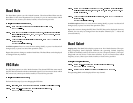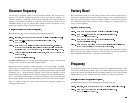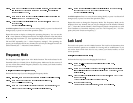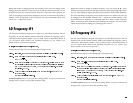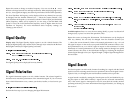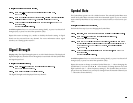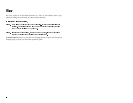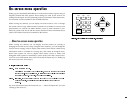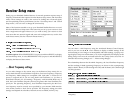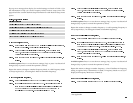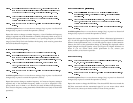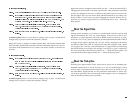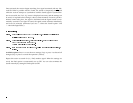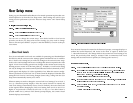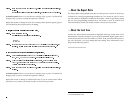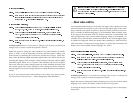
5HFHLYHU6HWXSPHQX
Setting up your Headend Satellite Receiver for normal operation requires setup of
frequency-related and other options from the Receiver Setup menu, and from other
menus. These settings are used by the receiver for locking onto a network signal,
and for optimizing receiver performance (see also “User Setup menu” and “Search
Setup menu”). You can view or change the current setup.
Most of the functions needed to set up your Headend Satellite Receiver are avail-
able from the Receiver Setup menu. This menu lets you set up your receiver to lock
onto a single network signal. However, if you wish to setup your receiver to lock
onto more than one network signal and store each configuration set, use the Net-
work Presets menu. (See also “Network Presets menu”.)
Available options: Select SEARCH SETUP (or press 2 and then SELECT) to display
the Search Setup menu, or select RECEIVER STATUS (or press 3 and then SELECT)
to display the Receiver Status menu.
«$ERXWIUHTXHQF\VHWWLQJV
As you make changes to the current setup (at the Receiver Setup menu), the re-
ceiver checks that the Local Oscillator frequencies, Crossover frequency, Frequency
and Frequency Mode settings are compatible with each other. A Crossover fre-
quency is required only if you are using both Local Oscillators (i.e., you have a
dual-band LNB and you are entering a Frequency with Downlink Mode set). If
used, the Local Oscillator Frequency #2 must be greater than Local Oscillator Fre-
quency #1. The operating Frequency, Local Oscillator frequencies plus the Cross-
over frequency must be correctly set as specified by your antenna/LNB manufac-
turer, dealer/reseller or local service provider. The Frequency setting plus other
settings used depend on subscriber/network services available, and may vary.
You can enter a valid frequency using the numbered Remote Control buttons,
and/or you can use the / arrow buttons to display available settings. If the
current setting is out of range or is incompatible with other settings, a pop-up mes-
sage displays setup error information, or N/A (Not Applicable) will display for the
setting. Setup errors must be corrected before the new setup can be saved. For in-
formation about saving changes, see “…About saving changes”.
The relationships between the Downlink frequency, the Local Oscillator frequency
and the resulting L-Band (operating) Frequency are shown in the accompanying
table for both C-Band (3.7 GHz through 4.2 GHz) and Ku-Band (10.7 GHz through
15 GHz) operation.
1
Frequency



